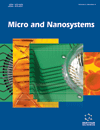- Home
- A-Z Publications
- Micro and Nanosystems
- Previous Issues
- Volume 14, Issue 1, 2022
Micro and Nanosystems - Volume 14, Issue 1, 2022
Volume 14, Issue 1, 2022
-
-
Exploring Therapeutic Potential of Invasomes, Transfersomes, Transethosomes, Oleic Acid Vesicles, and Cubosomes Adopting Topical/Transdermal Route
More LessAuthors: Shivani Verma and Puneet UtrejaBackground: Transdermal drug delivery is considered a better alternative to oral administration of drugs like proteins or peptides that are susceptible to extensive degradation via first pass metabolism. This delivery route also shows high patient compliance due to no use of painful injections. Conventional delivery systems like creams and gel show poor skin permeation and high dosing frequency. Objective: The obje Read More
-
-
-
The Toxic Side of Nanotechnology: An Insight into Hazards to Health and the Ecosystem
More LessAuthors: Sarita K. Yadav, Zulfequar Ahmed Khan, Brahmeshwar Mishra, Shiv Bahadur, Ajay Kumar and Babita YadavThe objective of the present article is to provide an insight into the toxicity aspects of nanoparticles on health and the ecosystem, along with risk assessment and monitoring. After a detailed screening of various research reports from peer-reviewed journals, books, and research news, the article was prepared. Nanotechnology's various significant advantages over conventional technologies have been explored for diverse r Read More
-
-
-
Chi-Squared Test Analysis on Hybrid Cryptosystem
More LessAuthors: Najmul H. Munshi, Proteeti Das and Subhasis MaitraNowadays, the internet has reached every aspect of our day-to-day life. The idea of cryptography is to provide security. It is an encryption technique used for network security when different networks are interconnected and become vulnerable to attacks and intrusions. Different algorithms, like DES, 3-DES, Modified DES, RSA, and Modified RSA algorithms for encryption, have been reported. In this paper, a hybrid Read More
-
-
-
Sodium Ligninsulfonate-assisted Synthesis of Lithium Bismuthate/bismuth Oxide Microspheres and Solar Light Photocatalytic Performance
More LessBackground: Great attention has been paid to the environmental pollution by organic dyes, which are difficult to be degraded in the natural environment and have been an unavoidable and urgent global problem. It is essential to develop green wastewater treatment technology with high removal efficiency and low-cost for protecting the surrounding and human health. Objective: The aim of the research is to synthesize lit Read More
-
-
-
Iron Nanoparticle Production by the Method of Electric Explosion of Wire
More LessAuthors: Elena Gryaznova and Alexey PustovalovBackground: The widespread use of iron nanopowders is connected with a wide range of characteristics such as size, magnetic characteristics and high surface area and that is why many researches present its different applications in the literature. Objective: The work studies the influence of the conditions for the iron wire electrical explosion on the course of the explosion process and the dispersed composition of the resultin Read More
-
-
-
Influence of Nano-sized Al2O3 Reinforcements on the Mechanical Behavior of the Al7075 Composites
More LessAims: Al7075 is a well-defined alloy for its excellent physical and mechanical behavior, such as high strength, toughness, and low density. To reach the expectations of the automobile and aerospace applications, the properties of Al7075 alloy have to be improved by reinforcing nano-sized Al2O3 particles. Objectives: Synthesis and characterization of the Al7075 alloy reinforced with Al2O3 nano particles for different structural engi Read More
-
-
-
Effect of Substrate on the Performance of Flexible Energy Storage Devices based on Surface Modified C60 – β Ni(OH)2 Nanocomposite
More LessAuthors: Soorya Sasi, Sunish K. Sugunan, Radhakrishnan N. P. and Suresh MathewAim: Aim of this study is to find the effect of the current collector on the performance of flexible energy storage devices based on surface modified organic-inorganic composite. Objective: As a part of our pursuit to develop flexible supercapacitive electrodes, we recently reported the fabrication of an electrode from an organic-inorganic composite slurry of surface functionalized fullerene and nickel hydroxide coated onto a coppe Read More
-
-
-
Dye-Sensitized Solar Cells Based on a New Type of Non-Volatile Co(II)/Co(III) Electrolyte Delivering Higher Power Conversion Efficiency for Indoor Applications
More LessAuthors: Soorya Sasi, Arya Sajeev, Sunish K. Sugunan, Pankajakshan R. Nair and Suresh MathewBackground: Electrolyte is an essential constituent of a dye-sensitized solar cell (DSSC) as it mediates charge transport and regenerates the oxidized dye. Iodide/triiodide (I-/I3-) based electrolytes are the ones widely being used in DSSCs. These types of electrolytes are usually made by dissolving high concentrations of triiodide and polyiodide species in solvents, such as acetonitrile and methoxypropionitrile. These solven Read More
-
-
-
Performance of Silicon Oil-Based Magneto-rheological Fluids Used for MR Dampers: An Experimental Approach
More LessAuthors: Mohamed Bakr, Ali Eldomuaty, Tamer Mansour, Hossam Hammad, Mohamed M. Dawood and Tamer NabilAim: The aim of this work was the preparation of the model Magneto-Rheological (MR) fluids to be used under the effect of an applied magnetic field operated under very low power requirement for the purpose of vibration reduction in automotive damper. Background: Magneto-rheological fluids are non-Newtonian fluids, which consist of magnetic particles scattered in a base liquid – a matter that can change its characteristi Read More
-
Most Read This Month
Article
content/journals/mns
Journal
10
5
false
en


